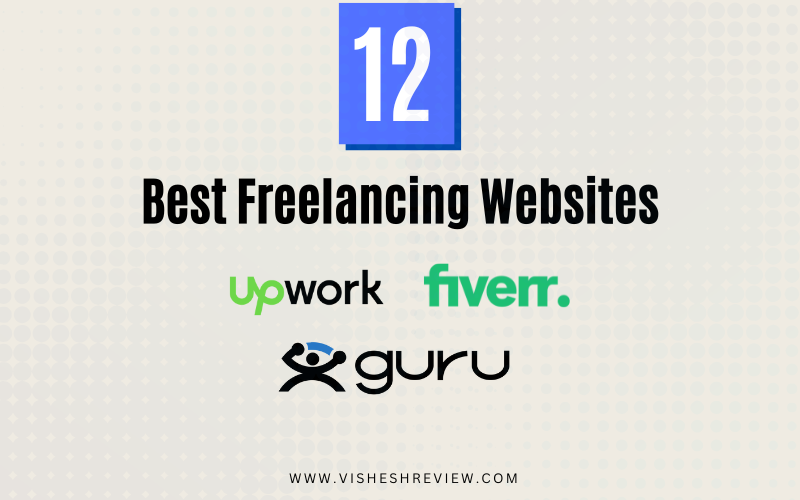
12 Best Freelancing Platforms to Start Your Career
Freelancing is an interesting experience, whether you’re new to it or want to expand your opportunities. These websites aim to connect you with clients and jobs that fit your skills. But let’s face it: no platform is flawless. So, get yourself a coffee, and we’ll explore 12 big freelancing platforms looking at what’s good and not so good about each.
- Upwork
- Fiverr
- Guru
- Freelancer
- PeoplePerHour
- Behance
- Dribbble
- Toptal
- SimplyHired
- Flexjobs
- 99designs
Upwork
The Big Daddy of Freelancing Platforms
Upwork is one of the largest freelancing platforms, offering projects in almost every niche imaginable. From web development to writing, it’s a go-to for professionals looking for diverse opportunities.
Pros:
- Huge client base, so plenty of work opportunities.
- Secure payment system with hourly and fixed-price project options.
- Great for long-term gigs and building client relationships.
Cons:
- Can be competitive for beginners.
- A 10% service fee is charged on most contracts.
- Some clients post low-paying jobs, so filtering is key.
Fiverr
“Starting at $5” (But Not Really)
Fiverr started as a platform for gigs priced at $5, but it has since evolved into a marketplace for freelancers offering services at varying rates.
Pros:
- Perfect for showcasing specific skills like graphic design or video editing.
- Easy to set up a profile and start selling services.
- Custom gig packages give you pricing flexibility.
Cons:
- You’ll need to hustle for visibility in a crowded marketplace.
- Fiverr takes a 20% cut of your earnings.
Guru
A Trusted Name in Freelancing
Guru is a reliable freelancing platform that focuses on building long-term relationships between freelancers and clients.
Pros:
- Supports flexible payment terms like hourly, milestone-based, or task-based payments.
- Lower fees (8.95%) compared to some competitors.
- Offers tools like WorkRooms for managing projects.
Cons:
- Less traffic than platforms like Upwork or Fiverr.
- Limited niche categories may not suit everyone.
Freelancer
The All-Rounder with Contests
Freelancer is one of the oldest platforms and is great for freelancers in various niches. Plus, their contests feature is perfect for showcasing your skills.
Pros:
- Contests can help you land projects and build your portfolio.
- Wide range of job categories.
- Milestone payment system ensures you get paid for completed work.
Cons:
- Can be overwhelming due to a high number of low-paying jobs.
- Charges both project fees and withdrawal fees.
PeoplePerHour
Freelancing with a UK Flair
If you’re in Europe, PeoplePerHour can be a great option, as it connects freelancers with clients in their local time zones.
Pros:
- Strong focus on European clients and freelancers.
- Easy-to-use dashboard for proposals and payments.
- Offers “Hourlies” for quick tasks.
Cons:
- Service fees are tiered (up to 20%), which can add up.
- Limited to specific niches, so it might not suit everyone.
The Social Network with Freelance Potential
LinkedIn isn’t just for job seekers—it’s also a goldmine for freelancers looking to connect with clients organically.
Pros:
- Ideal for professional networking and building your personal brand.
- Easy to find freelance gigs by connecting with industry leaders.
- Free to use, with options to upgrade for premium features.
Cons:
- Requires consistent effort to maintain your presence.
- Not a dedicated freelancing platform, so no built-in payment systems.
Behance
For the Creative Souls
Behance is a portfolio platform by Adobe, primarily for designers, photographers, and artists to showcase their work.
Pros:
- Beautiful and professional portfolio options.
- Great for getting discovered by potential clients.
- Strong creative community to connect and collaborate with.
Cons:
- No built-in job application or payment features.
- Limited to creative professionals, so not for everyone.
Dribbble
Where Design Meets Opportunity
Dribbble is a designer’s paradise, offering a platform to showcase your work and connect with clients.
Pros:
- Perfect for graphic designers, UI/UX experts, and illustrators.
- High-quality job postings from reputable companies.
- Strong community vibe.
Cons:
- You’ll need a paid Pro subscription to apply for jobs.
- Less diverse categories compared to platforms like Upwork.
Toptal
Freelancing for the Top 3%
Toptal is an exclusive freelancing platform for the best freelancers in tech, design, and finance.
Pros:
- High-paying, premium gigs for top-tier talent.
- Rigorous vetting ensures quality clients and freelancers.
- Focuses on long-term projects.
Cons:
- The application process is lengthy and competitive.
- Not suitable for beginners.
SimplyHired
Freelancing Meets Job Board
SimplyHired is more of a job search engine but also includes freelance and contract opportunities.
Pros:
- Simple to use with a broad range of job postings.
- No platform fees—direct client payments.
- Great for finding local freelance gigs.
Cons:
- Limited freelancer-focused tools.
- You’ll need to manage contracts and payments independently.
FlexJobs
Remote Work, Simplified
FlexJobs specializes in remote work opportunities, including freelancing gigs, for professionals across various industries.
Pros:
- Hand-screened job postings for legitimacy.
- Focus on work-life balance and flexibility.
- Broad categories, from writing to marketing to tech.
Cons:
- Monthly subscription fee to access job listings.
- You still need to pitch and manage client relationships independently.
99designs
Design-Centric and Proud
99designs is perfect for creative professionals, especially graphic designers, looking for freelance work or contests.
Pros:
- Great for building a portfolio through design contests.
- High-quality clients looking for specific design needs.
- Focused solely on creative work.
Cons:
- Contests can feel competitive and unpaid unless you win.
- High service fees can eat into your earnings.
So, which platform will you explore next? Let us know in the comments!
